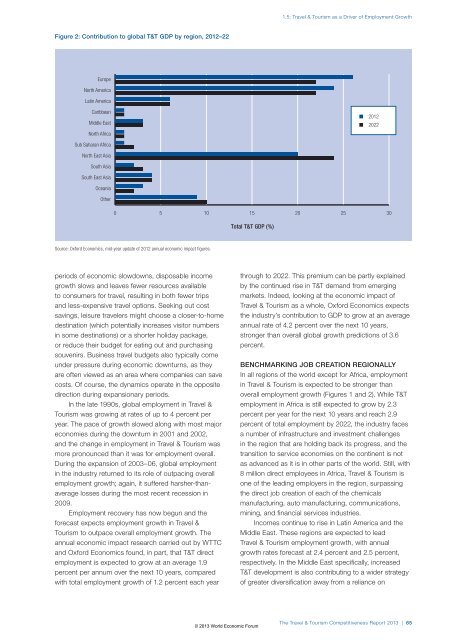The Travel & Tourism Competitiveness Report 2013
The Travel & Tourism Competitiveness Report 2013
The Travel & Tourism Competitiveness Report 2013
Create successful ePaper yourself
Turn your PDF publications into a flip-book with our unique Google optimized e-Paper software.
Figure 2: Contribution to global T&T GDP by region, 2012–22<br />
Europe<br />
North America<br />
Latin America<br />
Caribbean<br />
Middle East<br />
North Africa<br />
Sub Saharan Africa<br />
North East Asia<br />
South Asia<br />
South East Asia<br />
Oceania<br />
Other<br />
periods of economic slowdowns, disposable income<br />
growth slows and leaves fewer resources available<br />
to consumers for travel, resulting in both fewer trips<br />
and less-expensive travel options. Seeking out cost<br />
savings, leisure travelers might choose a closer-to-home<br />
destination (which potentially increases visitor numbers<br />
in some destinations) or a shorter holiday package,<br />
or reduce their budget for eating out and purchasing<br />
souvenirs. Business travel budgets also typically come<br />
under pressure during economic downturns, as they<br />
are often viewed as an area where companies can save<br />
costs. Of course, the dynamics operate in the opposite<br />
direction during expansionary periods.<br />
In the late 1990s, global employment in <strong>Travel</strong> &<br />
<strong>Tourism</strong> was growing at rates of up to 4 percent per<br />
year. <strong>The</strong> pace of growth slowed along with most major<br />
economies during the downturn in 2001 and 2002,<br />
and the change in employment in <strong>Travel</strong> & <strong>Tourism</strong> was<br />
more pronounced than it was for employment overall.<br />
During the expansion of 2003–06, global employment<br />
in the industry returned to its role of outpacing overall<br />
employment growth; again, it suffered harsher-thanaverage<br />
losses during the most recent recession in<br />
2009.<br />
Employment recovery has now begun and the<br />
forecast expects employment growth in <strong>Travel</strong> &<br />
<strong>Tourism</strong> to outpace overall employment growth. <strong>The</strong><br />
annual economic impact research carried out by WTTC<br />
and Oxford Economics found, in part, that T&T direct<br />
employment is expected to grow at an average 1.9<br />
percent per annum over the next 10 years, compared<br />
with total employment growth of 1.2 percent each year<br />
1.5: <strong>Travel</strong> & <strong>Tourism</strong> as a Driver of Employment Growth<br />
0 5 10 15 20 25 30<br />
Source: Oxford Economics, mid-year update of 2012 annual economic impact figures.<br />
Total T&T GDP (%)<br />
© <strong>2013</strong> World Economic Forum<br />
n 2012<br />
n 2022<br />
through to 2022. This premium can be partly explained<br />
by the continued rise in T&T demand from emerging<br />
markets. Indeed, looking at the economic impact of<br />
<strong>Travel</strong> & <strong>Tourism</strong> as a whole, Oxford Economics expects<br />
the industry’s contribution to GDP to grow at an average<br />
annual rate of 4.2 percent over the next 10 years,<br />
stronger than overall global growth predictions of 3.6<br />
percent.<br />
BENCHMARKING JOB CREATION REGIONALLY<br />
In all regions of the world except for Africa, employment<br />
in <strong>Travel</strong> & <strong>Tourism</strong> is expected to be stronger than<br />
overall employment growth (Figures 1 and 2). While T&T<br />
employment in Africa is still expected to grow by 2.3<br />
percent per year for the next 10 years and reach 2.9<br />
percent of total employment by 2022, the industry faces<br />
a number of infrastructure and investment challenges<br />
in the region that are holding back its progress, and the<br />
transition to service economies on the continent is not<br />
as advanced as it is in other parts of the world. Still, with<br />
8 million direct employees in Africa, <strong>Travel</strong> & <strong>Tourism</strong> is<br />
one of the leading employers in the region, surpassing<br />
the direct job creation of each of the chemicals<br />
manufacturing, auto manufacturing, communications,<br />
mining, and financial services industries.<br />
Incomes continue to rise in Latin America and the<br />
Middle East. <strong>The</strong>se regions are expected to lead<br />
<strong>Travel</strong> & <strong>Tourism</strong> employment growth, with annual<br />
growth rates forecast at 2.4 percent and 2.5 percent,<br />
respectively. In the Middle East specifically, increased<br />
T&T development is also contributing to a wider strategy<br />
of greater diversification away from a reliance on<br />
<strong>The</strong> <strong>Travel</strong> & <strong>Tourism</strong> <strong>Competitiveness</strong> <strong>Report</strong> <strong>2013</strong> | 65

















